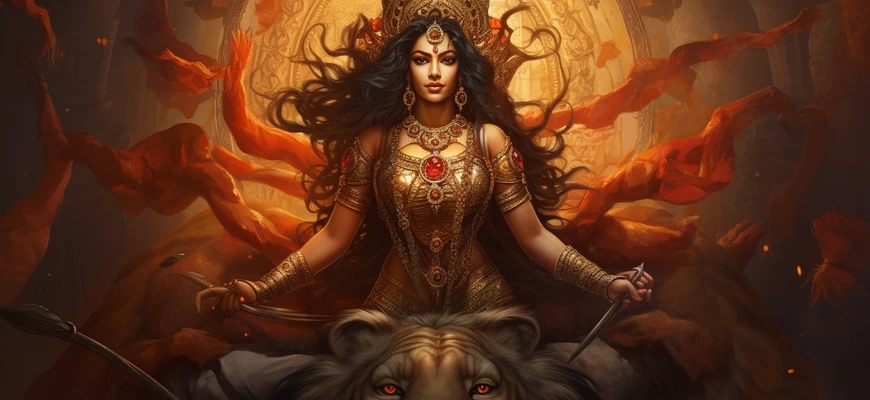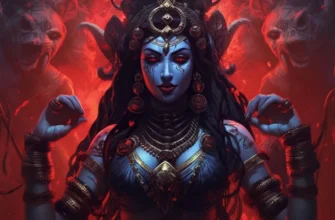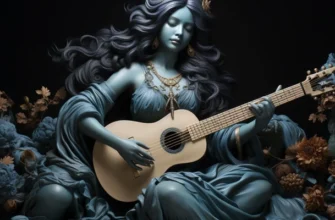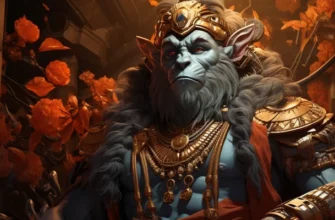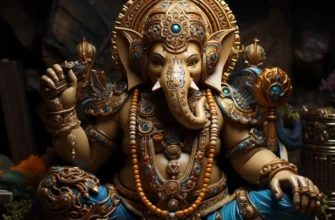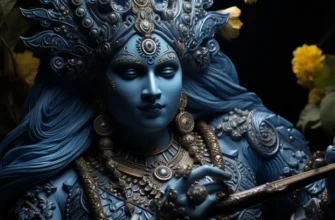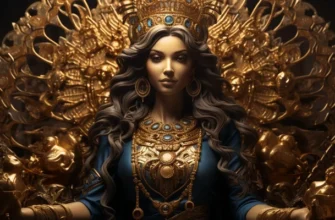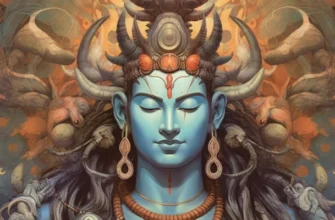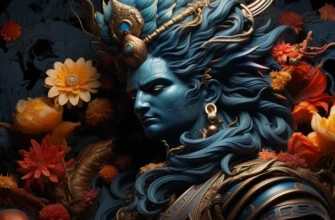Indian mythology honors the goddess Durga, the embodiment of power and invincible strength. According to legend, she was created by combining the energy of all the gods to destroy demons. Durga, with four arms and a tiger as her escort, symbolizes victory over evil. Her cult is important in religious rituals and festivals, and her image has a great cultural impact on Indian society.
- The role of the goddess Durga in the Indian mythological context.
- Mythological Origin.
- Goddess in Sacred Texts
- Legends and Myths
- Characteristics of the Goddess
- Symbolism of the goddess
- Goddess Durga has different aspects and appearances that reflect the various aspects of her character and functions:
- Role in Indian Society
- Religious Rites and Festivals
- National and regional festivals
- Rituals and Festivals of a different nature
- Cultural and Social Impact
- Contemporary Arts and Entertainment
- Festivals and Public Events
- Conclusion
The role of the goddess Durga in the Indian mythological context.
The goddess Durga plays a number of key roles in the Indian mythological context:
Protector: Durga is seen as an invincible protector who comes to the aid of the gods in the fight against demons and evil.
Destroyer of Demons: According to myths, Durga was created to destroy powerful demons such as Mahishasura who caused suffering to gods and humans.
Symbol of Strength and Courage: The image of Durga illustrates the unrivaled strength and courage that is needed to overcome challenges and enemies.
Aspects of Different Deities: Durga has different aspects such as Kali, Parvati, and others, representing different aspects of feminine energy and divine power.
Religious Rites and Festivals: The veneration of Durga is manifested in various religious rituals and festivals, particularly during Durga Puja, when huge statues of the goddess are erected and worshipped.
Interaction with Other Gods: Durga is an important part of the Indian pantheon and interacts with other gods such as Shiva, Vishnu, and Brahma.
Cultural Influence: The role of Durga in the Indian mythological context is not only religious, but also strongly influences the culture, art, and literature of Indian society.
Mythological Origin.
The mythological origin of the goddess Durga is reflected in various legends:
Creation of Durga: According to Indian mythology, Durga came into being by combining the energy of all the gods to confront and destroy the powerful demon Mahishasur, who had taken over the worlds.
Struggle and Victory: Durga came to fight the demons, which lasted nine days. She used her mighty strength and her ten-armed archer to defeat Mahishasur and his army.
Divine Plexus: Legend has it that the gods wove their powers together to create Durga, which has become a defining symbol of the struggle of good and the defeat of evil.
Aspects of Different Deities: Durga appears in different aspects such as Kali, Parvati, Amba, and others, indicating her universal role in Indian mythology.
Divine Unity: Her origin also symbolizes the unification of divine forces to protect the cosmic order and restore harmony in the world.
Goddess in Sacred Texts
The goddess Durga appears and is recognized in a number of sacred texts of Indian mythology. The main ones include:
“The Devi Bhagavata Purana: This epic work describes the creation of Durga as the divine protector of the gods and her war against the demon Mahishasura.
“Markandeya Purana: The text contains legends related to Durga, who comes into the world with the help of divine energy to destroy the evil demon.
“Devi-Mahatma: This text in the Markandeya Purana elaborates on the greatness and power of Goddess Durga, her manifestation, and her protective role in the world.
“Durga Saptashati: This text contains seventy verses that glorify Goddess Durga and describe her various aspects and abilities.
“Devi-Bhagavata Purana: This Purana provides details on the origin and activities of Durga as a great divine power that comes to the aid of the gods.
These textual sources not only reveal the role of Durga in mythology, but also deepen the understanding of its symbolism and influence on Indian religious and cultural tradition.
Legends and Myths
The legends and myths associated with the goddess Durga reveal her role in fighting evil and establishing cosmic harmony:
Defeating Mahishasur: One of the most famous legends is related to Durga’s battle with the demon Mahishasur, who had taken possession of the heavenly realms. Durga enters into a long war and, thanks to his invincible power, destroys Mahishasur, establishing order in the world.
The beginning of Durga: The Devi-Bhagavata Purana describes how the goddess Durga was born from the union of the energy of all the gods when they were powerless against the forces of evil.
The battle with Raktabij: Durga fights Raktabij, a demon whose properties are that every drop of his blood gives rise to a new demon. Durga defeats him by holding his blood in a large bowl.
The legend of Maa Sati: The legend of Sati, reborn as Parvati and becoming Durga, describes her strength and devotion in seeking a partner, leading to her union with the god Shiva.
Amba and Ajita: The Mahabharata tells the story of the goddess Amba, who turned into Durga to get revenge on Ajita, who begged her for the son she lost at the hands of Brihaspati.
These legends form the basis of the Durga cult and are marked by the incredible power and wisdom of the goddess in fighting evil and protecting the cosmic order.
Characteristics of the Goddess
The goddess Durga is characterized by various aspects, including symbolism, attributes, and different aspects of her appearance:
Symbolism:
Tiger: Durga is often depicted on a tiger cart, symbolizing strength, dignity, and character.
Ten Arms: Each hand has a different attribute, representing different aspects of the goddess and her ability to handle many tasks at once.
Weapons and Protective Amulets: Her arsenal includes a sword, arrow, trident, and other weapons used to overcome evil.
Aspects and Appearance:
Aspects: Durga can manifest in different aspects such as Kali (destruction), Parvati (harmony), and Amba (revenge), which emphasizes the diversity of her character.
Appearance: Usually depicted as a beautiful woman with many arms and recognizable attributes.
Specific Aspects:
Mahishasurmardini: As the “victor of Mahishasura”, she is noted for her role in fighting evil and restoring order.
Maa Kali: In the aspect of Kali, Durga embodies the most severe and unyielding form, representing the destruction of time and uncertainty.
Interaction with Other Deities:
Shiva: As the wife of Shiva, Durga is a symbol of feminine power and maternal love.
Lakshmi and Saraswati: Sometimes depicted alongside other goddesses, symbolizing the trinity-divine aspect of Brahma, Vishnu and Shiva.
The goddess Durga represents a universal and powerful force, and her image is an important symbol in the Indian religious and cultural tradition.
Symbolism of the goddess
The symbolism of the goddess Durga is embedded in various aspects of her image, which are reflected in attributes and defining features:
Tiger:
Symbol of Power: The tiger that Durga sits on or accompanies represents strength, power, and courage.
Ten Arms:
Multitasking: Each hand has its own attribute, indicating multitasking and the ability to handle different challenges at the same time.
Weapons and Amulets:
The symbol of the Fight against Evil: The sword, arrow, and other implements in Durga’s hands indicate a willingness to fight and defeat the forces of darkness.
Lotus:
A symbol of purity and spiritual development: The lotus held in one of the hands symbolizes purity, spiritual development and devotion.
The Third Eye:
Symbol of Intuition and Wisdom: The third eye, usually located on the forehead, represents intuition, wisdom, and the ability to penetrate the depths of truth.
White Dress:
A symbol of Purity and Virtue: The white dress of Durga is a symbol of purity, virtue and untaintedness.
Staff and Round Eyes:
Symbol of Protection and Bee-like nature: The rod and round eyes indicate bee-like nature and willingness to protect her worshippers.
This symbolism not only conveys different aspects of the goddess Durga, but also brings a deep meaning to her image that is of great significance to fans and researchers of Indian mythology.
Aspects and Appearance
Goddess Durga has different aspects and appearances that reflect the various aspects of her character and functions:
Kali:
The aspect of Destruction: Kali is the most severe aspect of Durga. She is depicted with black skin, holding a sword and the severed head of a demon. Kali’s appearance expresses power in the destruction of evil and darkness.
Parvati: The aspect of Harmony and Love: As Parvati, Durga has a softer look, symbolizing maternal love, femininity and harmony in family life.
Amba: Aspect of Vengeance: Amba is an aspect of Durga that embodies the energy of revenge and justice. She is depicted with an arrow and a bow.
Durga (Mahishasurmardini): The victor of Mahishasura: As Mahishasurmardini, Durga looks like a brave warrior who defeats the demon Mahishasura. She carries an arrow and a sword to symbolize victory.
Maa Sati: Sacrifice of Love: Sometimes Durga is represented as Maa Sati, who lost her husband, the god Shiva. In this form, she expresses devotion and sacrifice for the sake of love.
Maa Ambe: Motherhood and tenderness: As Maa Ambe, Durga expresses tenderness and maternal love, her appearance becomes the embodiment of maternal care and protection.
In various aspects and guises, Durga is represented as a divine force fighting evil, embodying various qualities and roles in Indian mythology.
Role in Indian Society
The goddess Durga plays an important role in various aspects of Indian society, spanning religious, cultural, and social spheres:
Religious Rites and Festivals:
Durga Puja: This is one of the most important and famous festivals in India, dedicated to Goddess Durga. It is celebrated in a grand style, with statues of the goddess, religious rituals and participation of worshippers.
Cultural and Social Influence: Art and Literature: The image of Durga is used in art, literature and music as a symbol of strength and liberation. Her stories and legends influence the cultural heritage.
Feminine Strength and Courage: The ideal of the Modern Indian Woman: Durga stands as a symbol of a modern, strong and independent woman. Her image inspires Indian women to show their own strength and courage.
Prayers for Prosperity: Daily Devotions: Many people in India honor the goddess Durga on a daily basis by offering prayers and petitions to her for protection and blessings.
Struggle against Inequalities: Symbol of Struggle: Her fight against demons reflects the desire to overcome evil and inequalities in society. Her image plays a role in stimulating people to fight for justice and dignity.
The goddess Durga is not only an object of faith, but also a powerful symbol for the formation of values and ideals in various spheres of Indian society.
Religious Rites and Festivals
Durga Puja:
Preparations for the Festival: It begins on the fourteenth day of the month of Ashwayuja (October-November). Devotees decorate their homes, prepare altars and buy statues of Durga.
Installation of the statues: On the seventh day of the festival, statues of Durga are installed in homes and public squares. This is accompanied by prayers and rituals.
Rite of Glorification: For nine days, worshippers perform a variety of bows and rituals, including special prayers and religious performances.
Struggle and Victory: On the eighth and ninth days, a theatrical performance of the legend of Durga’s fight with Mahishasur and his defeat, symbolizing the victory of good over evil, takes place.
Farewell and the Hike into the Water: On the tenth day, the statues of Durga say goodbye, and a procession of worshippers tries to take the goddess out on the water. This symbolizes her return to her cosmic residence.
National and regional festivals
Durga Puja in Kolkata:
Kolkata is famous for its lavish Durga Puja celebrations. Large pavilions, artistic statues, and large-scale parades make this celebration outstanding.
Navaratri in India:
The nine days of Navaratri preceding Durga Puja are marked by special prayers and obeisances that serve as preparation for the arrival of Durga.
Durga Puja in Western India:
In the western states of India, such as Gujarat and Maharashtra, Durga Puja is celebrated with great solemnity, accompanied by art, dance and festival processions.
Rituals and Festivals of a different nature
Batukama in Telangana:
Women decorate with flower arrangements and perform special dances to honor the goddess.
Durga Puja in Nepal:
In Nepal, the holiday is celebrated with large mass processions, rituals and prayers in temples.
These rituals and festivals are deeply rooted in the religious and cultural traditions of Indian society, promoting unity and showing devotion to Goddess Durga.
Cultural and Social Impact
Goddess Durga has a significant cultural and social influence in Indian society. Here are some aspects of this influence:
Art and Architecture: Painting and Sculpture: The image of Durga is often embodied in art, whether on canvas or in sculptural works.
Temple Architecture: Many temples in different parts of India are adorned with statues of the goddess Durga, marking her important place in religious architecture.
Festivals and Rituals: Durga Puja: This festival, celebrated nationally and regionally, is a major cultural event that brings together people of different backgrounds and classes.
Navaratri: The festival celebrates nine days of prayers, music, and dance, bringing out the richness of Indian culture.
Literature and Poetry: Epics and Poetry: The stories and legends of Durga are included in Indian epics such as the Mahabharata and Ramayana and are also reflected in poetry.
Contemporary Arts and Entertainment
Cinema and Television: The image of Durga is often used in Indian films and television series as a symbol of strength and justice.
Fashion and Design: The enduring popularity of Durga’s image can be seen in fashion, where she becomes an inspiration for designers to create elegant and artistic collections.
Women’s Emancipation and Social Equality:
Women’s Power and Independence: The image of Durga inspires women to discover their inner strength and fight for their rights and independence.
Combating Social Inequality: The legends of Durga, the fighter against evil and vice, support the idea of justice and equality in society.
The image of Durga is deeply rooted in Indian culture and has a significant impact on various aspects of society, promoting unity and developing the cultural heritage.
Modern Reflection
In contemporary Indian society, the image of Goddess Durga continues to be reflected in various aspects of culture, religion and society:
Festivals and Public Events
Durga Puja: This festival remains one of the largest and most important celebrations in India. Large public events, parades, and special events are celebrated in many cities.
Arts and Entertainment:
Movies and Music: The image of Durga is not only used in classical works, but is also reflected in contemporary Indian films and musical performances.
Contemporary Art Projects: Indian artists and designers use the image of Durga to create contemporary art installations and designs.
Religious Practices:
Modern Temple Rituals: Modern religious rituals take place in temples in which worshippers show their devotion to the goddess Durga through prayers and service.
Women’s Emancipation:
Female Power in Society: The image of Durga serves as a symbol of the modern, strong and independent woman. It influences the recognition and support of the role of women in modern Indian society.
Virtual Devotion:
Online Worship: With the advent of the internet and social media, virtual worship is growing in popularity, where fans can express their devotion to Goddess Durga in online communities and chat groups.
The image of Goddess Durga remains relevant in contemporary Indian society, serving as a source of inspiration, strength, and unity for millions of people.
Conclusion
The goddess Durga plays a key role in shaping Indian culture, affecting religious, cultural and social aspects of society. Her image symbolizes strength, courage, and protection, and her various aspects and legends are embodied in festivals, art, literature, and everyday life. The goddess Durga is not only an object of faith, but also a catalyst for social unity, inspiring devotion, cultural development, and the struggle for justice. Her importance in the contemporary and historical context demonstrates the profound influence of mythology on the transformation of cultural values in India.
The goddess Durga is not only a divine existence, but also an important part of the identity of the Indian people. Her reflection in various aspects of culture shows how she continues to inspire and reflect the dynamics of contemporary Indian society, becoming not only an archaic figure of the past but also a modern symbol of strength, unity and development. Thus, the goddess Durga leaves her indelible mark on the history and culture of India, contributing to the preservation and flourishing of its unique heritage.
